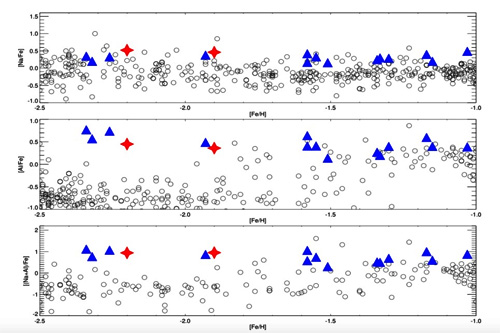 About 3621 light-years away in the Milky Way halo, scientists spotted two interesting stars. Though they have made their nest in the precincts of our Galaxy, the stars are actually alien and originated in global clusters – a collection of several million stars that were likely to have formed during the first one billion years of the Universe.
About 3621 light-years away in the Milky Way halo, scientists spotted two interesting stars. Though they have made their nest in the precincts of our Galaxy, the stars are actually alien and originated in global clusters – a collection of several million stars that were likely to have formed during the first one billion years of the Universe.
The Scientists from Indian Institute of Astrophysics (IIA), an autonomous institute under the Department of Science & Technology, Govt. of India have identified the stars on the basis of their peculiar abundance of chemicals like Aluminium and predict that they were once part of a globular cluster in our Galaxy or a globular cluster from a smaller galaxy that merged with Milkyway long back.
Globular clusters are a collection of several million stars and likely to have formed during the first one billion years of the Universe. They are an integral part of most galaxies, which hosted large number of globular clusters. Yet we don’t understand how and when during the lifetime of a galaxy these globular clusters are formed.
The research by Professor Sivarani Thirupathi from IIA and her team of collaborators which has been accepted for publication in Monthly Notices of the Royal Astronomical Society shows that the stars might have escaped from old globular clusters, based on the chemical abundances of Aluminium, Sodium, Carbon, Nitrogen, oxygen, Magnesium and several other chemical elements.
Gas in the Universe is enriched by stellar nucleosynthesis. Every generation of stars will enrich the gas with more and more heavy elements. In the case of star cluster, the enrichment can happen more rapidly as the processed nuclear material does not escape the cluster easily, is less diluted. So, rare events (by massive stars) that happened in the early Galaxy are preserved in the atmospheres of low mass stars of the clusters. The stars in the Globular clusters are enriched in Sodium and Aluminium.
Choosing the interesting candidates among several tens of thousands of stars from the low-resolution spectroscopic survey using automated analysis, the IIA team used the difference in the enrichment history to study stars that would have escaped from globular clusters. They used Aluminium as a key element to identify such escapees. The team generated a database of theoretical model spectra that is emitted by stars of different temperatures, metal content and carbon abundance. They also developed an automated code that determines metal content and carbon abundances for several millions of stars in a few hours. This helped to identify bright stars that are carbon poor in the globular cluster. They further studied them with high resolution with the Hanle echelle spectrograph, which is a high resolution, bench mounted, fibre-fed spectrograph at visible wavelengths for the 2metre Himalayan Chandra Telescope at Hanle in Ladakh remotely operated by IIA.
The newly discovered two stars by IIA team adds to a sample of just five stars that are studied in high resolution and these two globular cluster escapees are just about a 1kiloparsec distance from the Earth.
 Studying chemical elements and isotopes made in stars under these conditions by the IIA team will help probe nuclei that are far from the stability and help understand nuclear structure and physics under these environments. Understanding the sites of the light element production by the IIA team will provide insights to the formation and evolution of globular clusters.
Studying chemical elements and isotopes made in stars under these conditions by the IIA team will help probe nuclei that are far from the stability and help understand nuclear structure and physics under these environments. Understanding the sites of the light element production by the IIA team will provide insights to the formation and evolution of globular clusters.
Publication: Monthly Notices of the Royal Astronomical Society, Volume 494, Issue 1, May 2020, Pages 36–43,
https://academic.oup.com/mnras/article-abstract/494/1/36/5804790?redirectedFrom=fulltext
Fig1: A comparative study on the light-element abundances for Globular clusters and halo stars are shown. The blue upward triangles indicate chemical abundances of stars that belong to the Globular clusters, whereas the open circles indicate the halo stars. The two program stars discussed here are marked with red filled stars. The abundances resemble the globular cluster stars and not similar to halo stars. Hence they might have escaped from a cluster sometime during its evolution. The three panels show the distribution of the critical elements Na and Al with metallicity.
Fig2: The panels show the model fits observed spectra of Aluminium and Barium atomic transitions in the stars that escaped its clusters. The red lines denote the best-fit abundances, over-plotted with two synthetic ranges of abundances 0.25 dex higher and lower in blue and green, respectively. The names of the program stars and corresponding synthesized elements are provided in each panel.






























